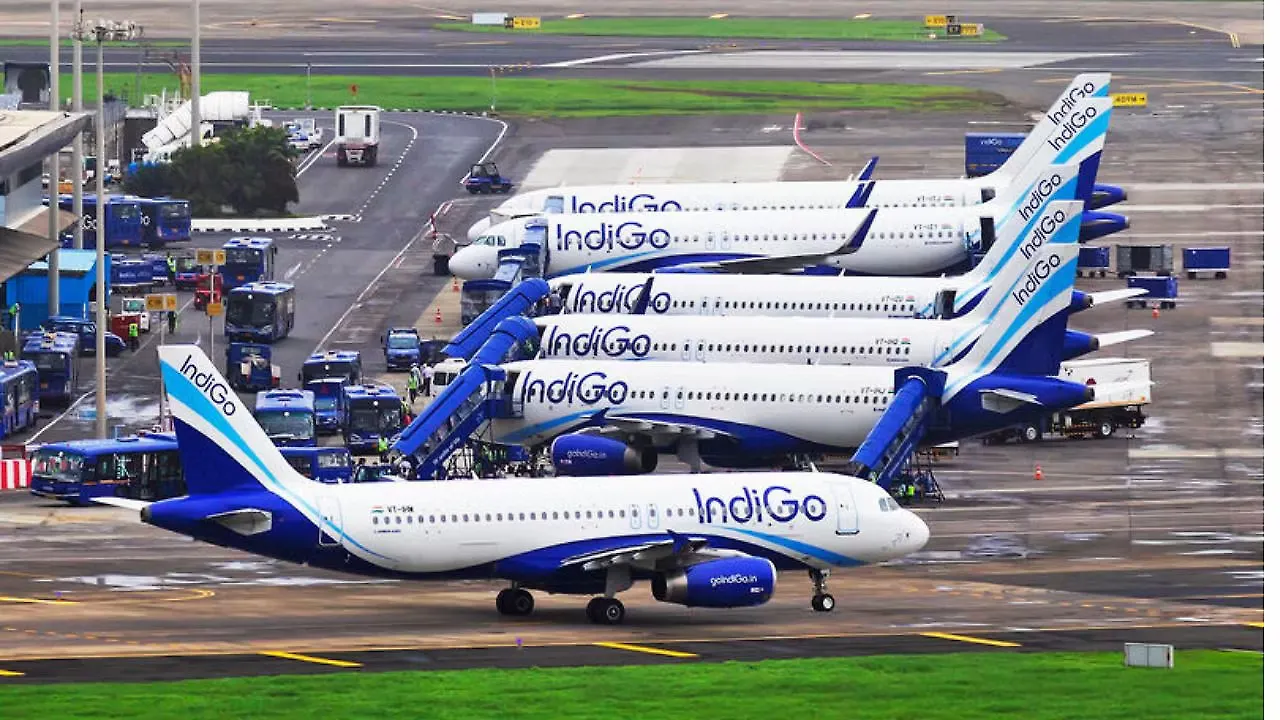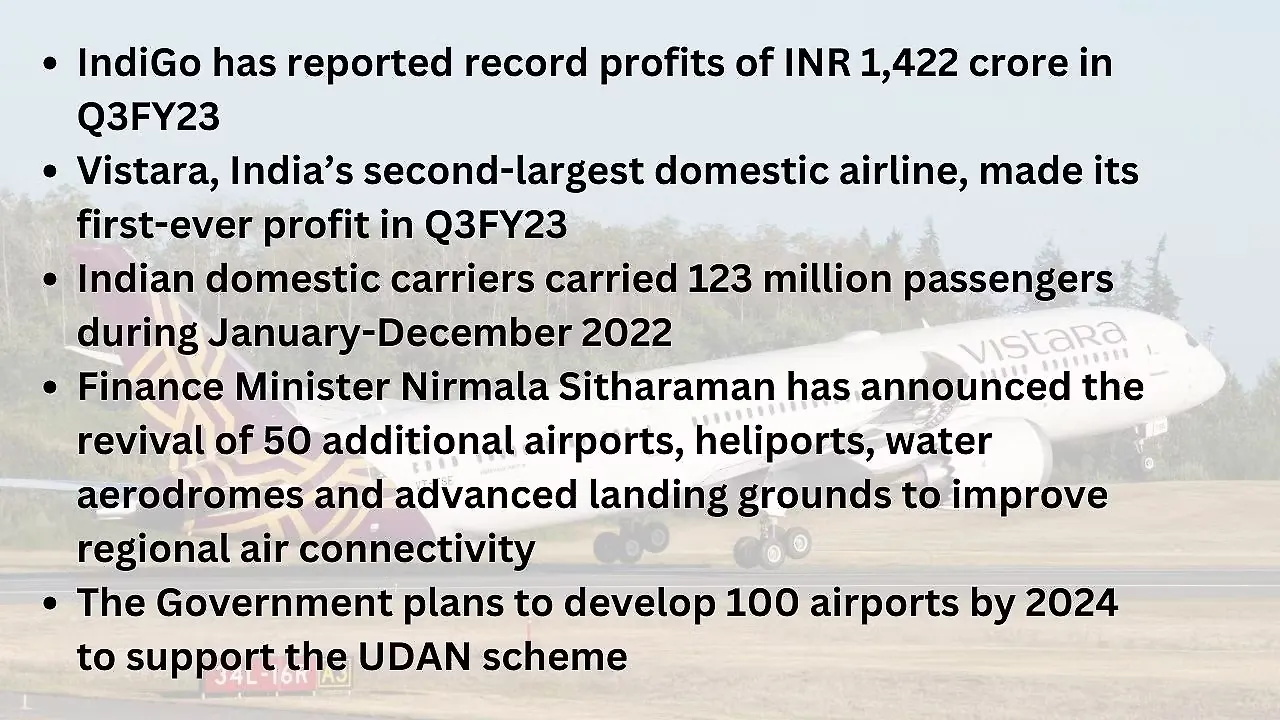
The Indian commercial aviation sector is on the road to recovery, which is a welcome sign for domestic airlines saddled with growing losses over the last few years.
Vistara and IndiGo have reported net profits in Q3FY23. While Vistara reported its first net profit since inception, IndiGo announced record profits in the quarter, signalling a long-awaited recovery in domestic air travel. IndiGo carried 22.3 million passengers in the quarter, an increase of 25.8% compared to last year. IndiGo’s total income for the quarter increased 62.6% to INR 15,410 crore, while revenues from operations rose 60.7% to INR 14,933 crore. Its net profits rose by more than eleven folds to INR 1,422 crore against INR 129.8 crore for the same period last year. IndiGo’s profits would have been even higher if not for a 52.4% increase in fuel prices.
According to IndiGo’s CEO, Pieter Elbers, the Q3FY23 performance was both operationally and financially strong in the backdrop of robust demand for air travel and the wide range of initiatives taken across the organisation beginning to yield results. Its total cash balance now stands at INR 21924.7 crore, comprising INR 106,12.5 crore of free cash. The healthy cash reserves are a valuable quiver in IndiGo’s armoury as it seeks to further consolidate its grip in the commercial aviation market with renewed competition from a resurgent Air India.

In a Linkedin post, IndiGo CFO Gaurav Negi said over 22 million passengers chose IndiGo as their preferred airline and were connected to over 100+ destinations with the airline’s modern fleet of 300+ aircraft. The airline has also regained its top spot in terms of on-time performance.
Vinod Kannan, CEO, Vistara, said 2022 was a phenomenal year for Vistara in terms of its operational and financial performance and that its significant network and fleet expansion had sustained growth over the last few months. With the airline crossing INR 8,000 crore in revenue and carrying over 11 million passengers in CY22, it became India’s second-largest domestic airline.
On the other hand, Air India recently confirmed that it was finalising an order for new jetliners to aid in its fleet expansion plans. A Reuters report in January indicated that the airline would acquire up to 500 aircraft, spread across 235 Airbus A320neo and 190 Boeing 737 MAX family single-aisle jetliners, along with 70 widebody jetliners, including 20 Boeing 787s, 10 777Xs and 40 A350s. The massive order for new aircraft, will provide Air India with significant economies of scale regarding crew training, flight operations and reduced maintenance and operating costs.
Its fleet now stands at 100, while Vistara has 52 aircraft, and IndiGo remains far ahead with 302 aircraft.
Return To Growth
India witnessed a double-digit CAGR of 14.5% in terms of domestic passenger traffic during the period 2014-15 to 2019-20. But this was severely impacted between 2020-22, when there was a precipitous decline in air travel and the survival of many domestic carriers was at stake.
Domestic air traffic is now well on the road to recovery and, according to MoCA, will rebound to approximately 97% of the pre-COVID levels in FY23. The passengers carried by Indian domestic carriers in CY22 grew to 123 million compared to 83.8 million the previous year, an increase of 47%.
The profitability of IndiGo and Vistara is a much-needed boost for the industry, with major Indian airlines having suffered losses totalling INR 28,907 crore in the last three years. According to the Ministry of Civil Aviation (MoCA), the losses to the industry were primarily due to the disruption caused during the pandemic, currency depreciation (USD/INR), high operating cost environment, especially due to the increase in ATF prices, increase in crude oil prices in the international market, VAT, Excise duty and ongoing Ukraine - Russia war.
For Indian carriers already operating in a highly competitive environment, the share of aircraft fuel and oil expenses, which is about 40% of their total operating expenses, is an additional burden.

However, the high VAT on ATF is being addressed, with 17 States/ Union Territories (UT) having reduced the former. While 15 States/UTs have reduced the VAT on ATF in the range of 1-4%, Gujarat, Goa, and Karnataka have made double-digit reductions. Another step taken by MoCA, which has benefited domestic carriers, is the reduction of GST rate for domestic Maintenance, Repair and Overhaul (MRO) services from 18% to 5%.
UDAN To Grow Further
In her Budget 2023 speech, Union Finance Minister Nirmala Sitharaman announced that 50 additional airports, heliports, water aerodromes and advanced landing grounds would be revived to improve regional air connectivity. The amount budgeted for regional air connectivity increased to INR 1,244 crore.
The Government plans to develop 100 airports by 2024 to support the UDAN scheme, with 72 airports, including nine heliports and two water aerodromes, already operationalised as on January 30, 2023.
Since the start of the UDAN in October 2016, more than 11.3 million passengers have travelled on over 2,16,000 UDAN flights. The Government also plans to operationalise 1,000 UDAN routes, which currently stands at 459 with 59 in Uttar Pradesh, 40 in Rajasthan, and 22 in Odisha.
Also Read:
IndiGo Records 11-Fold Growth In Net Profit